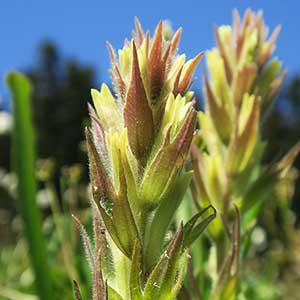Castilleja cryptantha
Castilleja pruinosa
Mt. Rainier or obscure paintbrush, obscure Indian paintbrush, obscure paintbrush
frosted Indian paintbrush, frosted paintbrush, pruinose paintbrush
few to several, erect or ascending, unbranched, hairs spreading, long, soft, eglandular, mixed with short stipitate-glandular ones.
several to many, erect or ascending, branched or unbranched, sometimes with inconspicuous, short, leafy axillary shoots, hairs ± dense, spreading to appressed, whitish or ashy gray, long, soft, much-branched, rarely unbranched, eglandular or obscurely glandular.
green, often with brown or purple veins, narrowly to broadly lanceolate, 1.5–4 cm, not fleshy, margins plane, ± involute, 0–3-lobed, apex acute to acuminate;
lobes spreading-ascending, narrowly lanceolate, apex acute to ± obtuse.
green, linear-lanceolate to narrowly or broadly lanceolate, 2–8 cm, not fleshy, margins plane to sometimes wavy, flat or involute, 0-lobed, sometimes 3–5-lobed distally, apex obtuse to rounded, sometimes acute;
lobes sometimes divergent, ascending-spreading, linear, apex acute.
(2.5–)3–6 × 1–2 cm; green to dull brown or dull reddish purple throughout, or proximally green to dull brown or dull reddish purple, distally yellow on apices, broadly lanceolate to ovate, (0–)3-lobed;
lobes ascending, narrowly lanceolate, long or short, arising near mid length, apex acute or acuminate.
3–20 × 1.5–4 cm;
bracts proximally greenish, distally abruptly red, sometimes yellow, salmon, or orange-red, often with a narrow yellow medial band, lanceolate, broadly lanceolate, or oblong, 0–5-lobed;
lobes spreading to ascending, linear, long, arising near mid length, apex obtuse to acute.
straight, 14–16 mm;
tube 11–14 mm;
whole corolla included within calyx;
beak adaxially pale yellow, 1–2 mm;
abaxial lip deep green, slightly inflated, 4–5 mm, 67% as long as beak;
teeth ascending, pale, 1.5–2 mm.
slightly curved, 20–51 mm;
tube 12–21 mm;
beak long-exserted, adaxially green, yellow, or red, 12–33 mm;
abaxial lip deep green, reduced, 1–2.5 mm, ca. 10% as long as beak;
teeth incurved to erect, white, yellow, or green, 0.5–2 mm.
proximally green or pale with green veins, lobes yellow, sometimes becoming deep red with age, 12–15 mm;
abaxial and adaxial clefts 3–7 mm, 25–50% of calyx length, deeper than laterals, lateral 1–3(–4) mm, 8–20% of calyx length;
lobes triangular, adaxial segments longer than abaxials, apex acute or obtuse.
proximally green to yellow, distally and abruptly colored as in distal bracts, often with a central yellow band, 13–28 mm;
abaxial clefts 5–13 mm, adaxial 8–14 mm, clefts 33–70% of calyx length, deeper than laterals, lateral 3–9 mm, 20–25% of calyx length;
lobes lanceolate to triangular, apex acute to acuminate.
= 24.
= 48.
Castilleja cryptantha
Castilleja pruinosa
Castilleja cryptantha is endemic to the vicinity of Mt. Rainier in the Cascade Range, with most populations found within Mt. Rainier National Park. Unlike most species of Castilleja, it is apparently self-pollinating (W. J. Duffield 1972); the small flowers are entirely enclosed within the yellowish calyces, which tend to grow deep reddish as they age. The purplish brown bracts are also unusual in the genus.
(Discussion copyrighted by Flora of North America; reprinted with permission.)
Castilleja pruinosa is a common and variable paintbrush at moderate elevations in the southern half of the Cascade Range, occurring westward in Oregon and in adjacent northwestern California. It is also found in the northern Sierra Nevada. The often dense pubescence of branched hairs distinguishes it from other similar species within its range. Castilleja gleasoni was sometimes included within C. pruinosa, but C. gleasoni is likely of hybrid origin and occurs only in the San Gabriel Mountains of southern California. There are significant morphological differences between C. gleasoni and C. pruinosa. Castilleja pruinosa forms occasional hybrids with C. applegatei var. pinetorum and with C. brevilobata. In some populations in Douglas and eastern Lane counties, Oregon, C. pruinosa forms introgressive swarms with C. hispida var. hispida.
(Discussion copyrighted by Flora of North America; reprinted with permission.)


